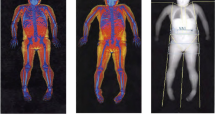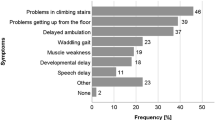Abstract
Background/Objectives:
Nutritional issues that are associated with Duchenne muscular dystrophy (DMD) remain poorly understood. The aim of this analysis was to describe and explore longitudinal observations of body mass index (BMI) in a cohort of children with DMD.
Subjects/Methods:
Anthropometric and clinical characteristics were collected retrospectively and longitudinally for boys with DMD seen in two large neuromuscular clinics. BMI Z-scores were determined using the Centers for Disease Control and Prevention reference values for children (2000).
Results:
Medical records (n=193) were examined from which 75% were included for analysis. The mean age of the cohort at the time of data collection was 11.9 years, with 72% of patients currently or previously using steroids. The highest prevalence of obesity based on the BMI Z-score was 50% at the age of 10 years. Longitudinally, BMI Z-scores from the age of 2 to 12 years plot approximately one s.d. above the mean, after which there is a marked and progressive decline. BMI gainers were identified for whom BMI Z-score increased by 1.65 units compared with the 0.09 units in non-gainers. BMI gainers were younger when they had their first BMI measurement (5.9 vs 7.2 years), and this measure was significantly lower compared with the non-gainers (BMI Z-score: 0.04 vs 1.17). In this cohort, BMI was associated with age, ambulatory status and lung function.
Conclusions:
This study demonstrates that boys with DMD using steroid therapy experience shifts in BMI. A declining BMI appears to be associated with increasing age. Interpretation of growth patterns is limited here by a lack of normative growth references in DMD.
This is a preview of subscription content, access via your institution
Access options
Subscribe to this journal
Receive 12 print issues and online access
$259.00 per year
only $21.58 per issue
Buy this article
- Purchase on Springer Link
- Instant access to full article PDF
Prices may be subject to local taxes which are calculated during checkout



Similar content being viewed by others
References
Bushby K, Finkel R, Birnkrant DJ, Case LE, Clemens PR, Cripe L et al. Diagnosis and management of Duchenne muscular dystrophy, part 1: diagnosis, and pharmacological and psychosocial management. Lancet Neurol 2010; 9: 77–93.
Davidson ZE, Truby H . A review of nutrition in Duchenne muscular dystrophy. J Hum Nutr Diet 2009; 22: 383–393.
Willig TN, Carlier L, Legrand M, Riviere H, Navarro J . Nutritional assessment in Duchenne muscular dystrophy. Dev Med Child Neurol 1993; 35: 1074–1082.
McDonald CM, Abresch RT, Carter GT, Fowler WM Jr, Johnson ER, Kilmer DD et al. Profiles of neuromuscular diseases. Duchenne muscular dystrophy. Am J Phys Med Rehabil 1995; 74: S70–S92.
Martigne L, Salleron J, Mayer M, Cuisset J-M, Carpentier A, Neve V et al. Natural evolution of weight status in Duchenne muscular dystrophy: a retrospective audit. Br J Nutr 2011; 105: 1486–1491.
Biggar WD, Harris VA, Eliasoph L, Alman B . Long-term benefits of deflazacort treatment for boys with Duchenne muscular dystrophy in their second decade. Neuromuscul Disord 2006; 16: 249–255.
Strober JB . Therapeutics in Duchenne muscular dystrophy. NeuroRx 2006; 3: 225–234.
Balaban B, Matthews DJ, Clayton GH, Carry T . Corticosteroid treatment and functional improvement in Duchenne muscular dystrophy: long-term effect. Am J Phys Med Rehabil 2005; 84: 843–850.
Bianchi ML, Biggar D, Bushby K, Rogol AD, Rutter MM, Tseng B . Endocrine aspects of Duchenne muscular dystrophy. Neuromuscul Disord 2011; 21: 298–303.
Sorva RA, Turpeinen MT . Asthma, glucocorticoids and growth. Ann Med 1994; 26: 309–314.
Kuczmarski R, Odgen C, Grummer-Strawn L, Flegal K, Guo S, Wei R et al. CDC Growth Charts: United States. Advance Data from Vital and Health Statistics; No 314. National Center for Health Statistics: Hyattsville, Maryland, USA, 2000.
National Health and Medical Research Council. Clinical Practice Guidelines for the Management of Overweight and Obesity in Children and Adolescents. Commonwealth of Australia: Canberra, Australia, 2003.
Pallant J SPSS Survival Manual, 4th edn. Allen & Unwin: Crows Nest, NSW, Australia, 2011.
Nagel BHP, Mortier W, Elmlinger M, Wollmann HA, Schmitt K, Ranke MB . Short stature in Duchenne muscular dystrophy: a study of 34 patients. Acta Paediatr 1999; 88: 62–65.
Andrada LE, De Vito EL . Clinical and spirometric alterations in patients with Duchenne muscular dystrophy. Medicina 1996; 56: 463–471.
Biggar WD, Gingras M, Fehlings DL, Harris VA, Steele CA . Deflazacort treatment of Duchenne muscular dystrophy. J Pediatr 2001; 138: 45–50.
Department of Health and Aging. 2007 Australian National Children’s Nutrition and Physical Activity Survey—Main Findings. Commonwealth of Australia: Barton ACT, Australia, 2008.
Pessolano FA, Suarez AA, Monteiro SG, Mesa L, Dubrovsky A, Roncoroni AJ et al. Nutritional assessment of patients with neuromuscular diseases. Am J Phys Med Rehabil 2003; 82: 182–185.
Bushby K, Bourke J, Bullock R, Eagle M, Gibson M, Quinby J . The multidisciplinary management of Duchenne muscular dystrophy. Curr Paediatr 2005; 15: 292–300.
Leung DG, Germain-Lee EL, Denger BE, Wagner KR . Report on the Second Endocrine Aspects of Duchenne Muscular Dystrophy Conference December 1–2, 2010, Baltimore, Maryland, USA. Neuromuscul Disord 2011; 21: 594–601.
Gauld LM, Kappers J, Carlin JB, Robertson CF . Height prediction from ulna length. Dev Med Child Neurol 2004; 46: 475–480.
Author information
Authors and Affiliations
Corresponding author
Ethics declarations
Competing interests
The authors declare no conflict of interest.
Rights and permissions
About this article
Cite this article
Davidson, Z., Ryan, M., Kornberg, A. et al. Observations of body mass index in Duchenne muscular dystrophy: a longitudinal study. Eur J Clin Nutr 68, 892–897 (2014). https://doi.org/10.1038/ejcn.2014.93
Received:
Revised:
Accepted:
Published:
Issue Date:
DOI: https://doi.org/10.1038/ejcn.2014.93
This article is cited by
-
The burden, epidemiology, costs and treatment for Duchenne muscular dystrophy: an evidence review
Orphanet Journal of Rare Diseases (2017)
-
Sleep Disordered Breathing in Duchenne Muscular Dystrophy
Current Neurology and Neuroscience Reports (2017)
-
Pulmonary Manifestations of Neuromuscular Diseases
The Indian Journal of Pediatrics (2015)



